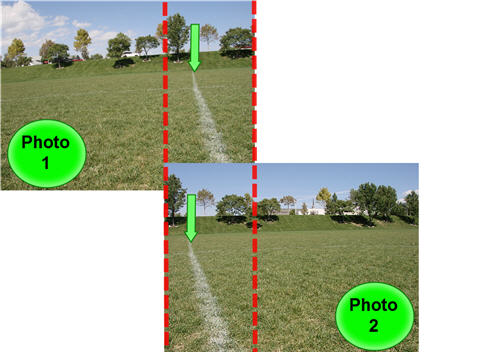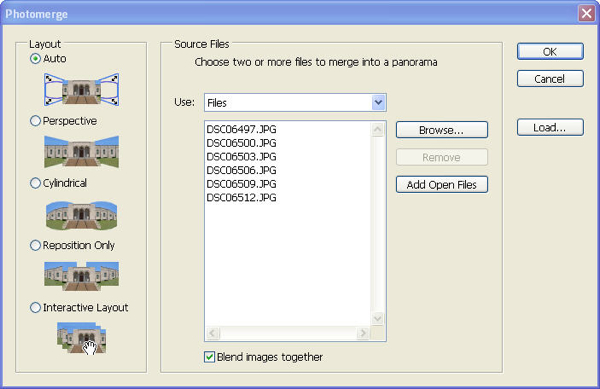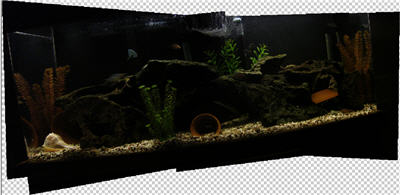How to Create a Panorama with Photoshop and Photomerge
This post on Creating a Panorama with Photoshop and Photomerge has been submitted by Matt Dawdy from www.TheRightPic.com.
A panorama is simply a wide-angled view of a physical space. To the photographer a panorama is usually several photographs that are stitched together horizontally to create a seamless picture.
This is going to be a pretty simple tutorial in which we create a panorama using Photoshop’s Photomerge utility.
Here are the tools I am going to use to create panoramic photos:
1. A digital camera
2. A tripod or a stable surface or platform to take pictures from that allows some horizontal rotation
3. A computer and Adobe Photoshop and the Photomerge utility
When I started thinking about this tutorial I began to wonder what I should shoot. Just about any subject can be used for a panorama, however traditional panoramic photography subjects are typically landscapes or city skylines. I will show you a few different panoramas that I created, some typical, some a little different than what you would normally see for a panorama.
Setting up for your shoot:
A stable position to take your panoramas from is important. Isn’t it always when taking pictures? Well, with panoramas it is more important because the Photoshop process that joins your photos together is good at what it does but it is not perfect and when it has trouble putting the individual pictures together it either leaves ragged white lines in between the photos or chops large sections out of the photos because it doesn’t know what to do with them.
I would recommend you use a tripod since it allows you to turn your camera slightly in order to take successive shots. If you can’t use a tripod some sort of flat surface like the top of a wall, fence or a board may work as long as it is possible to take a picture and then rotate your camera slightly and then take another picture without vertical movement.
Once you find your potential spot and set your camera up, rotate it to the extreme right and left edges that you want to include in your photo and make sure that there isn’t anything that is too big of a visual or physical obstruction. Something else to keep in mind is to try to set up so that the full range of your shot does not show shadows from you or your camera.
The actual shoot:
For the panoramic pictures I take I start at the extreme left of what I want to capture, set my timer and take bracketed exposure shots. I then stop and check the photos without moving the camera. If one of them looks OK I am ready to continue. If not, I adjust my settings and shoot again from the same spot.
When you have the settings you want and have taken your extreme left pictures it is time to grab a reference point in the viewfinder about 20%-30% away from the right side of your viewfinder. You do this because you are going to swivel the camera so that this reference point is at the far left but still in the viewfinder so that there is some overlap between your photos.

The green arrows show my chosen reference point, which is a point that I will use to make sure I don’t swivel too far to the right and leave a gap in between my two pictures. The dotted line represents the overlap that I am going to have between this and my next picture. The second picture is shown diagonally lower than the other one for display purposes only.
As far as overlap is concerned, you are shooting digitally so snap away, overlap 30-50% if you want, but err on the side of overlapping too much. If you don’t overlap enough, as Photoshop’s Photomerge app attempts to blend the shots it will not have enough of a fingerprint to blend well and your panorama will end up with the ragged white lines that I wrote about earlier or look like Frankenstein’s version of a panorama.
Once you mentally choose a reference point such as a tree or prominent peak swivel the camera to the right until your reference point is almost at the left edge of the viewfinder. Try not to move the camera position, vertical pitch or height. Once you have swiveled far enough repeat the process that you did to take the first picture.
Now simply repeat this process until you come to the extreme right end of your desired panoramic shot:
1. Choose a reference point about 20-30% away from the right edge of the viewfinder
2. Swivel the camera to the right until your reference point is at the left edge of the viewfinder
3. Take the picture
4. Repeat until you have taken photos that cover the entire area you wish to capture in your panorama
Make your panorama:
Now you are ready to ’stitch’ your photos together.
1. Open each photo that you wish to add to the panorama in Photoshop. Open them sequentially, starting with the leftmost one first.
2. In Photoshop CS3 (or CS2, not sure about other versions) go to File > Automate > Photomerge
3. In the dialog that appears choose Auto and then click the “Add Open Files” button
4. Check the filename numbers of the photos that are added, assuming you allow your camera to number your photos. If you started off shooting from the left of the panorama the lower numbers should be at the top. In other words, it should read something like this:

If the filenames are out of order remove all of the ones that are before the one that should be first. Now just click Add Open Files again and it will add the pictures back in. Keep removing files and adding them back until you have your files in order.
Click OK. Now Photoshop goes into action. It analyzes and blends the photos. This could take several minutes. Once it is finished you will see what Photoshop and Photomerge could make out of your photos.

Here is my neighbor’s fish tank. A lot of it got lost in the Photomerge process, in fact I would guess that I lost about 50% of my picture material which is probably due to the fact that the images are dark and very similar and Photomerge probably had a difficult time piecing it together. Still, the picture isn’t a total loss. One thing that did happen that is common with Photomerged pictures is that it is on a slight tilt to the left.
If this happens to you, first flatten your image and then do an Arbitrary rotation until the picture looks level.
Next, crop the picture. If you are unfamiliar with how to do this just press C. Click and drag a box over the area of the picture you want to keep. Press ENTER and the rest of the photo will be gone.
Next, you might want to adjust your saturation, exposure, hue levels, etc, until you are happy with the photo. Make sure you zoom in all of the way to 100% and look the photo over, zoom back out and move around. Look for obvious problems with the picture.
As for me, I have a fishtank with a couple of blurry fish but a decent looking photo that ends up being 88″ wide by 23″ long, give or take a little.
When you are done playing with the coloring and exposure do a Smart Sharpen by going to Filter > Sharpen > Smart Sharpen. I would set the Amount to 60% and set the Radius to 1.0. Click OK.
Go ahead and save your picture and you have a panorama! Here is mine with the default Photoshop frame action added (the photo has been shortened and saved at a low res to make it more web palatable) (click to enlarge the following image):
Given time I would add a couple of good looking fish from other photos and clean up some of the rough spots, but this is a good start.
Here are a couple of other panoramas that I took (click to enlarge):
A field near where I work. The actual panorama is 204″ x 24″.
Here are some homes and a range of mountains with the waste from a giant copper mine. Actual panorama is 94″ x 23″
Matt Dawdy is one of the contributors and a blogger for the free stock photography site, www.TheRightPic.com






Panorama photography is very interesting stuff. As you say, a tripod / stable surface is very important in this process - however, it is not always required.
I like taking skies and water body snaps in panorama - here’s one of mine (yay, plug!) that I like a lot : http://sightings.loneroad.info/index.php?showimage=104
Whoops- meant this one: http://sightings.loneroad.info/index.php?showimage=105
I’ve read somewhere it was a good idea to set the camera to manual (exposure and focus) and have the setting for every shot taken. The results feel more like one big photo. I haven’t tried yet.
Also, from my own experience, don’t use a short focal lenght (like a wide angle), you will have less distortion to cope with, like with this picture:
Here’s the link to the image:
http://www.flickr.com/photos/88603711@N00/434168261/in/set-72157594235690125
I don’t do a whole lot of panoramas, but when I do I use a stitching software called “Autostitch“. It’s free and it does an exceptional job. The neat thing about it is that you don’t have to worry about alignment, tilt, and order because the software takes care of it automatically (hence the “Auto” in Autostitch). The other cool thing about it is that it will handle 2D stitches so you can shoot a whole area and stitch the photos together to make a super-photo. Anyways, neat software to play with.
I love making panoramas, here’s a recent one I’ve made:
http://hhalmaghi.com/photos/blacktuskpanoLARGE.jpg
Too bad the main thing I wanted to capture in the pano was in the clouds…
I agree with Brian. Autostitch is amazing. Just feed the photos into the software and it does everything automatically with exceptional results. I usually cannot see at all where the different parts were blended together. It looks as if the panorama was taken just like that. And it’s completely free.
I think that the most important thing while photographing panoramas is to use the manual or aperture priority setting. You want to keep a constant aperture across all of your shots so that the depth of field is consistent. I agree that you should also set the focus to manual.
zut is right…using the same exposure for every shot can help
I too can recommend autostitch.
And as well as regular panoramas, its sometimes fun to try to create a panography. Its pretty much the same but not everything fits together nicely.
Couple of examples:
http://farm1.static.flickr.com/207/448422819_ec33f98412_b.jpg
http://farm1.static.flickr.com/168/459944877_b394f425ff_b.jpg
Nick, that’s a great idea, I love them, I think I’ll try that next time I get the chance.
It took me a long time waiting infront of my computer for the Photoshop to stitch it all but the result is good, better than other stitching software. you can see some of it here:
http://jollence.blogspot.com/2007/10/borneo-rainforest-lodge-panorama-photos.html
i don’t really take panoramic shots but use stiching in my bike photos!!!!!!!
http://www.flickr.com/photos/alienscream/374007959/
http://www.flickr.com/photos/alienscream/471916194/
I personaly use Auto Pano Pro. Not free but works amazingly well. For best results shoot manual and shoot each shot as quick as possible to reduce light change. I have found that pictures turn out the best with exactly the same settings(apeture,shuter speed) focal length does not matter (atleast with autopano pro.)
Here are some of my panos: http://visiblephoto.com/index.php?link=cat_R57
I also agree with Brian, and he has a great website for those of you who haven’t checked it out. I recently did a pano from the stands of a college football game and it did a very nice job even though I couldn’t setup a tripod for the images.
1. I second (or third, or umpteenth) AutoStitch — http://www.cs.ubc.ca/~mbrown/autostitch/autostitch.html
2. Recently, I ran across http://viewat.org — a cool site for publishing cylindrical/spherical panoramas (that is, panorama shots you can pan through online). There are some great panorama photos there, and you can upload your own.
I suggest Hugin. It uses autopano and enblend to create some incredible Panoramic images. You have much more control over the photos going in and the way it looks coming out, also you get an incredible end product.
Plus, it’s free.
A tip:
If you’re stitching together photos, they don’t have to be *horizontally* displaced from one another. You can always stich together shots taken vertically!
Great tip thank you.
Here’s my effort using this utility from a recent trip to Bora Bora, French Polynesia -
http://tinyurl.com/yst7c4
Those sound like good packages to try. Thank you for the responses. I will try out some of those packages.
Matt Dawdy
Did this one with the stitch assist program that came with my Canon s3 (actual size is much bigger).
http://farm3.static.flickr.com/2024/1547579879_a24154485b_b.jpg
It is best to shoot panos in portrait that way you get more information up and down. For wider pictures you just need to take more shots.
made with this tutorial:
http://www.digitalreality.ws/photos/panoramas/index.html
Thx a bunch!
Thanks a lot - I used these instructions for my first panaroma which was much easier than I expected.
http://www.flickr.com/photo_zoom.gne?id=1583583154&size=l
For those on a Mac, I’ve found the DoubleTake (http://echoone.com/doubletake/) software to be really useful. Just drag the photos (from Aperture/iPhoto/Finder) to DoubleTake and viola you have a panoramic.
thx for the great site!
This is great, but a little complicated for me. If you are looking for a simple way to create panoramas using free software, check out my post. Hope it helps!
Great tutorial, but there are lots of free programs that can do all the work for you, no need to use CS3 or any other tool like that! Check out my article on how to create panoramas for free.